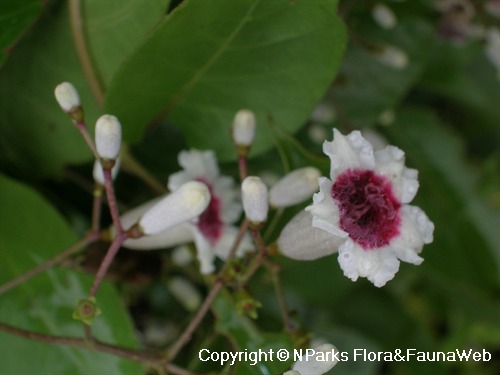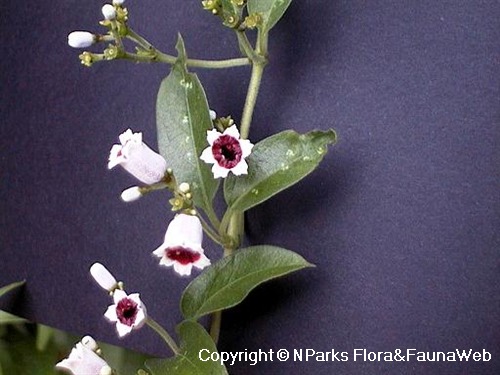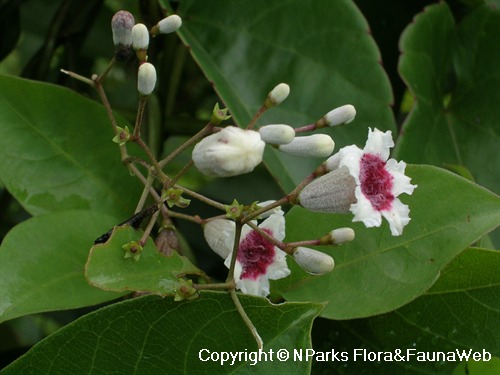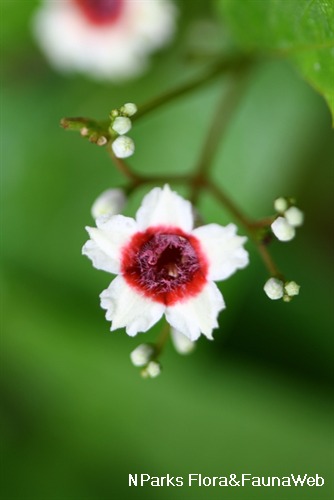_lowres.jpg)
Back
Paederia foetida L.
| Family Name: | Rubiaceae |
| Synonyms: | Paederia scandens (Lour.) Merr., Paederia tomentosa Blume |
| Common Name: | Lesser Malayan Stinkwort, Akar Sekentut, Daun Kentut-kentut, 鸡矢藤, 鸡屎藤 |
Name
Classifications and Characteristics
| Plant Division | Angiosperms (Flowering Seed Plants) (Dicotyledon) |
|---|---|
| Plant Growth Form | Climber |
| Lifespan (in Singapore) | Perennial |
| Mode of Nutrition | Autotrophic |
| Plant Shape | Irregular |
| Maximum Height | 7 m |
Biogeography
| Native Distribution | India, South Korea, Japan, Taiwan, Thailand, Myanmar, Peninsular Malaysia, Singapore, Borneo, and the Philippines |
|---|---|
| Native Habitat | Terrestrial (Secondary Rainforest, Coastal Forest, Grassland / Savannah/ Scrubland, Disturbed Area / Open Ground), Shoreline |
| Preferred Climate Zone | Tropical, Sub-Tropical / Monsoonal |
| Local Conservation Status | Native to Singapore (Least Concern (LC)) |
Description and Ethnobotany
| Growth Form | It is a climber up to 7 m long and has young parts that are without hair to densely covered with hair. Its leaves smell unpleasant when crushed. |
|---|---|
| Foliage | Its opposite, stalked leaves have blades that are usually egg- or lance-shaped with a pointed tip, 2–21 by 0.7–9 cm, and have 4–5 pairs of fine veins. |
| Flowers | Its flowers are white with a violet centre, have funnel-shaped corollas that are densely covered with hair. The flowers are arranged in clusters at leaf axils or at the end of flowering branches. |
| Fruit | Its fruit is slightly round and 4–6 mm wide. Its seed dispersal units (diaspores) are slightly round, 3.5–5.5 by 3–5 mm, black, and without an obvious wing. |
| Habitat | It grows on beaches and forest margins. It occurs locally in Kranji, in the vicinity of Upper Peirce reservoir and other sites. |
| Cultivation | It can be propagated by seed. |
| Etymology | Greek, paederos means opal, which refers to the opal-like translucency of fruits in some species. Latin foetida, stinking, referring to the unpleasant smell of the leaves. |
| Ethnobotanical Uses | Edible Plant Parts : Edible Leaves Food (Fruit or Vegetable): The leaves are eaten in China (Hainan, Guangxi, Guangdong regions) grounded and cooked with rice flour, sugar, coconut milk as part of sweet recipes such as dumplings (tang yuan) or in savoury dishes as a stir-fry. Medicinal: The juice of the leaves has medicinal purpose. The leaves are used in traditional home remedies for cough, colds and to lower body "heatiness". |
Landscaping Features
| Landscaping | It may be suitable for parks, growing over trellises and pergolas, and vertical greening of buildings. |
|---|---|
| Desirable Plant Features | Ornamental Flowers |
| Landscape Uses | Parks & Gardens, Small Gardens, Coastal, Beachfront / Shoreline, Trellis / Arbour / Pergola |
Fauna, Pollination and Dispersal
| Fauna Pollination Dispersal Associated Fauna | Butterfly-Attracting (Flower Nectar), Butterfly Host Plant, Moth Food Plant |
|---|---|
| Pollination Method(s) | Biotic (Fauna) |
| Seed or Spore Dispersal | Biotic (Fauna) |
Plant Care and Propagation
| Light Preference | Full Sun |
|---|---|
| Water Preference | Moderate Water |
| Plant Growth Rate | Fast |
| Rootzone Tolerance | Moist Soils, Well-Drained Soils, Saline Soils / Salt Spray, Fertile Loamy Soils, Easy to Grow |
| Maintenance Requirements | Low |
| Propagation Method | Seed |
Foliar
| Foliage Retention | Evergreen |
|---|---|
| Mature Foliage Colour(s) | Green |
| Mature Foliage Texture(s) | Smooth |
| Foliar Type | Simple / Unifoliate |
| Foliar Arrangement Along Stem | Opposite, Whorled |
| Foliar Attachment to Stem | Petiolate |
| Foliar Shape(s) | Non-Palm Foliage (Lanceolate, Elliptical) |
| Foliar Venation | Pinnate / Net |
| Foliar Margin | Entire |
| Foliar Apex - Tip | Acuminate |
| Foliar Base | Rounded / Obtuse |
Floral (Angiosperm)
| Flower & Plant Sexuality | Bisexual Flowers |
| Flower Colour(s) | White, Purple |
|---|---|
| Flower Texture(s) | Velvety / Furry / Tomentose |
| Flower Grouping | Cluster / Inflorescence |
| Flower Location | Axillary, Terminal |
| Flower Symmetry | Radial |
| Individual Flower Shape | Tubular |
| Flowering Period | Free-Flowering |
Fruit, Seed and Spore
| Mature Fruit Colour(s) | Brown |
|---|---|
| Fruit Classification | Simple Fruit |
| Fruit Type | Fleshy Fruit , Non-Accessory Fruit |
| Mature Seed Colour(s) | Black |
| Seed Quantity Per Fruit | Few (1-5) |
Image Repository
Others
| Master ID | 166 |
|---|---|
| Species ID | 1462 |
| Flora Disclaimer | The information in this website has been compiled from reliable sources, such as reference works on medicinal plants. It is not a substitute for medical advice or treatment and NParks does not purport to provide any medical advice. Readers should always consult his/her physician before using or consuming a plant for medicinal purposes. |

_lowres.jpg)





_lowres.jpg)
_lowres.jpg)
_lowres.jpg)
_lowres.jpg)